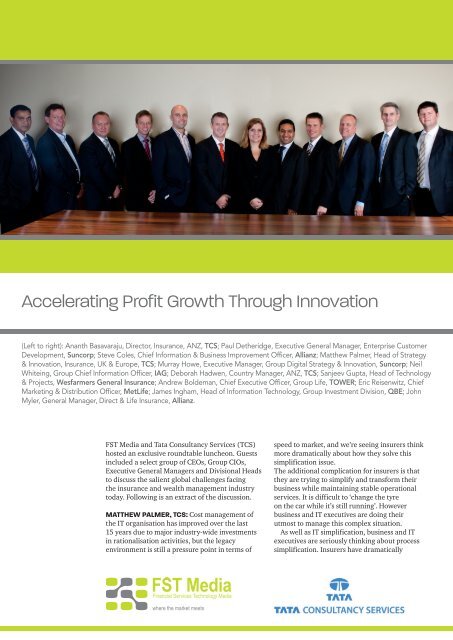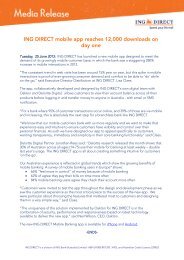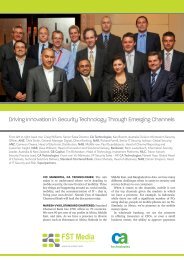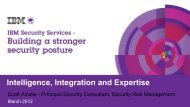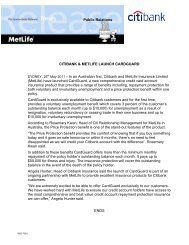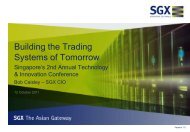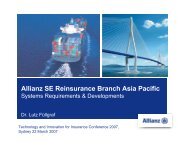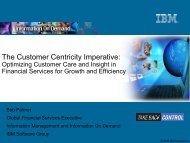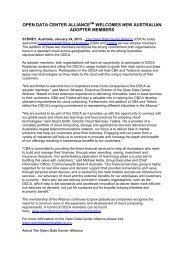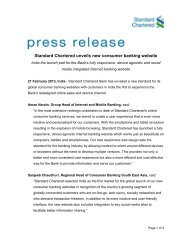Accelerating Profit Growth Through Innovation - FST Media
Accelerating Profit Growth Through Innovation - FST Media
Accelerating Profit Growth Through Innovation - FST Media
You also want an ePaper? Increase the reach of your titles
YUMPU automatically turns print PDFs into web optimized ePapers that Google loves.
<strong>Accelerating</strong> <strong>Profit</strong> <strong>Growth</strong> <strong>Through</strong> <strong>Innovation</strong><br />
(Left to right): Ananth Basavaraju, Director, Insurance, ANZ, TCS; Paul Detheridge, Executive General Manager, Enterprise Customer<br />
Development, Suncorp; Steve Coles, Chief Information & Business Improvement Officer, Allianz; Matthew Palmer, Head of Strategy<br />
& <strong>Innovation</strong>, Insurance, UK & Europe, TCS; Murray Howe, Executive Manager, Group Digital Strategy & <strong>Innovation</strong>, Suncorp; Neil<br />
Whiteing, Group Chief Information Officer, IAG; Deborah Hadwen, Country Manager, ANZ, TCS; Sanjeev Gupta, Head of Technology<br />
& Projects, Wesfarmers General Insurance; Andrew Boldeman, Chief Executive Officer, Group Life, TOWER; Eric Reisenwitz, Chief<br />
Marketing & Distribution Officer, MetLife; James Ingham, Head of Information Technology, Group Investment Division, QBE; John<br />
Myler, General Manager, Direct & Life Insurance, Allianz.<br />
<strong>FST</strong> <strong>Media</strong> and Tata Consultancy Services (TCS)<br />
hosted an exclusive roundtable luncheon. Guests<br />
included a select group of CEOs, Group CIOs,<br />
Executive General Managers and Divisional Heads<br />
to discuss the salient global challenges facing<br />
the insurance and wealth management industry<br />
today. Following is an extract of the discussion.<br />
MATTHEW PALMER, TCS: Cost management of<br />
the IT organisation has improved over the last<br />
15 years due to major industry-wide investments<br />
in rationalisation activities, but the legacy<br />
environment is still a pressure point in terms of<br />
speed to market, and we’re seeing insurers think<br />
more dramatically about how they solve this<br />
simplification issue.<br />
The additional complication for insurers is that<br />
they are trying to simplify and transform their<br />
business while maintaining stable operational<br />
services. It is difficult to ‘change the tyre<br />
on the car while it’s still running’. However<br />
business and IT executives are doing their<br />
utmost to manage this complex situation.<br />
As well as IT simplification, business and IT<br />
executives are seriously thinking about process<br />
simplification. Insurers have dramatically<br />
Financial Services Technology <strong>Media</strong><br />
where the market meets
<strong>Accelerating</strong> <strong>Profit</strong> <strong>Growth</strong> through <strong>Innovation</strong><br />
“Due to this situation<br />
some important<br />
customer journeys<br />
remain a barrier to<br />
customer experience<br />
and cost management<br />
objectives.”<br />
– Matthew Palmer, TCS<br />
“Some of these<br />
organisations could<br />
have dramatically<br />
improved their<br />
processes through<br />
things like Business<br />
Process Management<br />
(BPM) or other<br />
technologies. So it is<br />
‘horses for courses’<br />
there are lots of<br />
variables to consider.”<br />
– Steve Coles, Allianz<br />
improved services and processes via line of<br />
business improvement projects, but with<br />
constrained resources and budgets they have been<br />
unable to completely optimise some fundamental<br />
processes. Due to this situation some important<br />
customer journeys remain a barrier to customer<br />
experience and cost management objectives.<br />
Cloud is a potential enabler of IT optimisation<br />
and effectiveness objectives. However its<br />
suitability is dividing IT executives and as<br />
such, it is yet to gain acceptance as a mainstream<br />
technology solution amongst insurers. Some say,<br />
“We want to sample what cloud is about because<br />
we believe it can help with operational efficiency.”<br />
Therefore one area of interest is around<br />
using cloud services to provide development<br />
and testing environments in order to help<br />
with business change and configuration<br />
management commitments. The other area<br />
of interest in cloud services is around data<br />
management and business intelligence – where<br />
data cleansing, data processing and data<br />
enrichment is enhanced by cloud services.<br />
Due to this situation some important customer<br />
journeys remain a barrier to customer experience<br />
and cost management objectives. Rightfully so.<br />
The challenge for IT executives is how to<br />
manage costs and we believe cloud services<br />
will continue to offer value to insurers in<br />
meeting this key objective.<br />
Regulators are looking at the insurance<br />
industry and saying it needs greater transparency<br />
regarding the risks the businesses are facing<br />
and the capital reserves it holds to offset these<br />
risks. Australian insurers recently challenged<br />
the local regulator and succeeded in achieving a<br />
less onerous approach to capital management,<br />
but the whole risk management area will<br />
remain a hot topic for the next few years.<br />
Data privacy is another key issue, especially<br />
with the proliferation of multiple channels<br />
including the emerging mobile and social media<br />
channels. Considering how we maintain data<br />
privacy whilst also connecting with customers<br />
over new channels like social media<br />
and mobile, it will continue to be an IT<br />
objective for the foreseeable future.<br />
Additionally, insurers are also noting<br />
they can enhance their brand by maximising<br />
their marketing intelligence, including<br />
intelligence from social networking environments.<br />
Technologies are available that can automate<br />
these tasks and we’re seeing people increasingly<br />
interested in using electronic listening tools<br />
to decipher inferences from positive and<br />
negative market commentary. Data privacy<br />
remains a key concern for insurers operating in<br />
this arena.<br />
Predictive analytics will also be a differentiating<br />
capability for business teams for the next<br />
few operating periods. The whole product<br />
configuration process is under review in this<br />
geography as well as in other countries.<br />
How do you increase speed to market of your<br />
product and pricing changes? How do you<br />
achieve future looking product and pricing views,<br />
rather than the deterministic and historical<br />
views that we’ve worked with? Predictive analytics<br />
will be increasingly significant in product and<br />
pricing areas as well as other functional areas.<br />
The customer experience around integrated<br />
channels is the last point I will cover. How can<br />
we improve customer retention in terms<br />
of integrated channels that improves the<br />
customer experience? Australia has a good<br />
set of retention numbers but retention rates<br />
are under threat in other parts of the world.<br />
This will remain a critical battleground for<br />
insurers and people are talking about how<br />
multi-channel integration will help them<br />
achieve their customer experience objectives.<br />
ANANTH BASAVARAJU, TCS: In addition,<br />
we observe the need for bringing the cost<br />
optimisation to manage the closed book<br />
policies in the Australian life insurance<br />
market. Businesses are keen to explore<br />
new avenues in this space.<br />
ANDREW BOLDEMAN, TOWER: The position<br />
is probably different here from other markets.<br />
There is a proliferation of closed book outsourcing<br />
in the UK especially, but we have not seen<br />
it so much in Australia. None-the-less many<br />
organisations are still facing the issue of legacy<br />
products; sometimes different series on one<br />
system, or one product on multiple systems,<br />
particularly if there has been an acquisition.<br />
MATTHEW PALMER, TCS: Business and<br />
IT executives are increasingly considering<br />
Business Process Outsourcing (BPO) and<br />
closed book outsourcing. At TCS we have an<br />
operating unit specialising in BPO and we have<br />
helped clients to rationalise and improve the<br />
quality of their processes and data through<br />
the BPO approach. The industry appears to<br />
be increasingly open to BPO for closed book<br />
of business to achieve their objectives.<br />
ANDREW BOLDEMAN, TOWER: Scale is very<br />
important across these markets. With the<br />
proliferation of technologies and things that<br />
people can invest in, you need scale to invest<br />
in different channels simultaneously. We look<br />
at return on investment and value. We’re in a
<strong>Accelerating</strong> <strong>Profit</strong> <strong>Growth</strong> through <strong>Innovation</strong><br />
business where price is important, so being able<br />
to deliver quality service at an appropriate<br />
price is critical.<br />
STEVE COLES, ALLIANZ: I have seen organisations<br />
that have outsourced or offshored and they’ve<br />
spent many years moving a clumsy process and<br />
it remains pretty much the same clumsy process<br />
with a lower cost. Some of these organisations<br />
could have dramatically improved their processes<br />
through things like Business Process Management<br />
(BPM) or other technologies. So it is ‘horses for<br />
courses’ and there are lots of variables to consider.<br />
MATTHEW PALMER, TCS: It’s about making<br />
intelligent decisions. There are certain functions<br />
that you will want to keep in-house. There are<br />
important aspects of a value chain in terms<br />
of ‘getting it right’ and if you’ve got a clumsy<br />
process you want to reengineer the process<br />
to get it right. Hence the increasing focus on<br />
business process optimisation by business and IT<br />
executive teams. Business Process Outsourcing<br />
is about making decisions where you can extract<br />
value from certain areas of your business.<br />
MURRAY HOWE, SUNCORP: I come from a<br />
marketing background and I see two juxtaposing<br />
forces. From a customer perspective I see<br />
increasing complexity – the rise of social, online,<br />
media fragmentation – bringing increased cost<br />
to engage and acquire. The business however is<br />
looking for greater simplicity of operations and<br />
lowering cost. What does that mean for TCS,<br />
and how are other people dealing with it?<br />
Matthew Palmer, TCS: The ideal approach<br />
is to drive down the costs, not just from a cost<br />
arbitrage point of view, but also from a sustainable<br />
transformation of the business processes point<br />
of view. Within our project work for clients we<br />
always strive to improve the technology and<br />
also re-engineer and automate processes. It is<br />
desirable to achieve IT and business process<br />
optimisation together in order to reduce the<br />
pressure on costs and operational objectives.<br />
You mentioned new channels, new media, but<br />
you’ve also got to build in regulatory initiatives.<br />
You’ve got to drive the costs down whilst<br />
creatively thinking about new functionality<br />
and not blowing your budget. This is where<br />
Software-as-a-Service (SaaS) will come into play<br />
because a service approach can help manage<br />
your costs of delivering new functionality.<br />
In the future we believe organisations will<br />
consider business and IT simplification using<br />
SaaS, in an effective way that’s palatable<br />
to the risk profile of the organisation.<br />
JAMES INGHAM, QBE: Many global players<br />
have seen regulatory risks across different<br />
environments. Do you find organisations in<br />
different countries approaching cloud computing<br />
with concern about regulatory environments<br />
and the effect based on where they’re located?<br />
MATTHEW PALMER, TCS: It’s a test-and-learn<br />
approach at the moment and if regulatory<br />
requirements are involved there is real<br />
nervousness. If there are opportunities where<br />
the data can be masked to protect data privacy<br />
within the guidelines set out by the regulator,<br />
then people are beginning to dip their toes<br />
in the water as far as cloud is concerned.<br />
JAMES INGHAM, QBE: Even before<br />
they’ve seen the regulatory test cases?<br />
MATTHEW PALMER, TCS: People are testing it<br />
themselves. They will develop the environment<br />
approach first before they take critical business<br />
and IT operations into a cloud environment.<br />
JAMES INGHAM, QBE: Are they waiting<br />
for a level of regulatory approval that<br />
indicates it’s been tested in the courts so<br />
they’re not exposed? Our external audit has<br />
very thin frameworks to say if one is<br />
on the straight and narrow. They’re<br />
waiting for that proofing side.<br />
MATTHEW PALMER, TCS: There is a great level<br />
of attention that is involved with any data that<br />
can identify customers; it’s an area of strict<br />
control and conservatism. People are trying<br />
to build their knowledge around how to do<br />
this effectively in the short and long term.<br />
SANJEEV GUPTA, WESFARMERS GENERAL<br />
INSURANCE: It’s more than just conservatism.<br />
The Australian Prudential Regulation Authority<br />
(APRA) has regulations and concerns around<br />
customer data being overseas. Until APRA changes<br />
its mind, things aren’t going to move much.<br />
NEIL WHITEING, IAG: At IAG we’re assuming<br />
the regulations aren’t going to change any time<br />
soon. We’ll always lag what’s going on from a<br />
business process or IT perspective. We’re heading<br />
down the path of simplification, exposing the<br />
services. Within that there are additional<br />
customer data services around tokenisation<br />
so I don’t always need to send name, address,<br />
telephone number and so on. For us cloud<br />
is about workloads and where we send<br />
those workloads. We’re not outsourcing,<br />
in fact I know where my data centre is.<br />
“Many global players<br />
have seen regulatory<br />
risks across different<br />
environments.”<br />
– James Ingham, QBE<br />
“From a customer<br />
perspective I see<br />
increasing complexity...<br />
the business however<br />
is looking for greater<br />
simplicity of operations<br />
and lowering cost.”<br />
– Murray Howe, Suncorp
<strong>Accelerating</strong> <strong>Profit</strong> <strong>Growth</strong> through <strong>Innovation</strong><br />
“We believe we will<br />
have to tokenise; we<br />
believe we will have<br />
to scrub data. We’re<br />
starting to develop<br />
those capabilities rather<br />
than waiting for APRA<br />
to catch up with us.”<br />
– Neil Whiteing, IAG<br />
“There is a truism: The<br />
most customer-focused<br />
process you can<br />
design will often be<br />
the most efficient.”<br />
– John Myler, Allianz<br />
Once we start to virtualise our Intel<br />
environments, I’m out of the hardware business.<br />
What do I care where one virtual environment<br />
is versus another? We’ll start with workloads<br />
that don’t matter. The complexity comes in<br />
because it’s not encapsulated within a controlled<br />
environment. We’re going to layer on complexity<br />
around authentication, authorisation and<br />
data management.<br />
Once people learn to manage and get<br />
comfortable with it, then cloud becomes more<br />
real. That’s why people go for a virtual private<br />
cloud, because they don’t know how to deal<br />
with the authentication/authorisation issue<br />
and how to attest to APRA that customer data<br />
isn’t in the Philippines or wherever. What’s the<br />
difference between a virtual private cloud and<br />
a highly virtualised environment in my own<br />
data centre? Not a lot, from an economic model<br />
perspective. We believe we will have to tokenise;<br />
we believe we will have to scrub data. We’re<br />
starting to develop those capabilities rather<br />
than waiting for APRA to catch up with us.<br />
SANJEEV GUPTA, WESFARMERS<br />
GENERAL INSURANCE: Looking at<br />
everything that is available with the cloud<br />
arrangement at the moment, it’s more of<br />
a managed service than a ‘true cloud’.<br />
NEIL WHITEING, IAG: What do you mean by<br />
a ‘true cloud’?<br />
SANJEEV GUPTA, WESFARMERS GENERAL<br />
INSURANCE: It’s not a ‘pay by the drink’ service,<br />
you’ve still got to own the bar to buy a drink.<br />
Amazon has got it; and so does Microsoft, but that<br />
is more aimed at consumer type service and not<br />
corporate users. Corporate applications that I’m<br />
seeing are named cloud but are managed services.<br />
STEVE COLES, ALLIANZ: The cloud solution today<br />
doesn’t justify the hype. Sometimes I<br />
wish they would sell me the software and I’ll<br />
stick it in my data centre. However, I can see<br />
the market changing especially where there<br />
is a stronger reliance on centrally managed<br />
infrastructure and where the market is looking<br />
for more cost effective solutions to reduce risk.<br />
At the moment, it has the risk of being a<br />
technology that a user could manipulate.<br />
People could get a credit card out and get a<br />
whole bunch of exciting stuff. Then data<br />
management and IT control principles are<br />
suddenly out of the equation. It has the<br />
risk of enabling a ‘cowboy IT country’ at<br />
the moment, but I’m sure it will settle into<br />
something a lot more serious and valuable.<br />
Our IT governance is embedded in the<br />
organisation; people don’t go out and select<br />
an IT solution just because it’s accessible.<br />
However we have to get the IT plumbing right<br />
for any commercial opportunity we need to<br />
explore. We’re looking at Salesforce as a case<br />
study to see how we can empower the business<br />
to do some practical stuff and leverage the<br />
technology, but still have the appropriate<br />
controls around it. We’re not quite there yet.<br />
JOHN MYLER, ALLIANZ: I agree. Insurers are a<br />
risk-based business and need to avoid importing<br />
operational risks. From an IT perspective,<br />
we are conservative around the adoption of<br />
new technologies. As a distribution owner<br />
I’m also faced with increasing diversity from<br />
my customer base and I need to leverage my<br />
existing processes multiple ways across multiple<br />
sites. It requires an agility to meet customer<br />
complexity head-on and respond appropriately.<br />
MATTHEW PALMER, TCS: John, in terms of<br />
managing down costs, what’s your viewpoint on<br />
how the industry will address this situation?<br />
JOHN MYLER, ALLIANZ: I look at it from a<br />
user perspective and what the technology will<br />
allow me to do. There is a truism: ‘The most<br />
customer-focused process you can design<br />
will often be the most efficient’. So start with<br />
the customer experience, design the internal<br />
process accordingly, and then deploy technology<br />
to support it end to end. Companies who<br />
start with what the potential cost savings<br />
technology can bring and then try to retrofit it<br />
into a business can end up with higher overall<br />
operating cost and a poor customer outcome.<br />
STEVE COLES, ALLIANZ: In 2005 we separated<br />
‘running the business’ from ‘changing the<br />
business’. Part of my organisation just focuses<br />
on taking business costs down. That’s given<br />
me the opportunity to reinvest in a framework for<br />
keeping our IT expense ratio competitive.<br />
If I can make savings of $2 for every $100 of<br />
insurance premium, then from a competitive<br />
perspective it means that we can grow more<br />
by offering a better price, a better<br />
profit or a mixture of the two.<br />
ERIC REISENWITZ, METLIFE: Part of the<br />
issue is timing when the benefits of the newly<br />
implemented technology catch up with the<br />
cost savings that you’re trying to accomplish.<br />
One of the challenges we face when we implement<br />
new technology is catching up with our customers’<br />
own systems, but there’s also part of the
<strong>Accelerating</strong> <strong>Profit</strong> <strong>Growth</strong> through <strong>Innovation</strong><br />
customer base that is not ready to move, so there<br />
is parallel running of old programs with the<br />
new online technologies. The savings you’re<br />
expecting to get from the new automation<br />
don’t always match up with your investment<br />
at exactly the same time. More importantly,<br />
customers don’t want to pay for it. Once they<br />
see the ‘new world’ they think that should<br />
be standard, and they assume your price<br />
includes that. Other industries have made<br />
these moves such as the airline industry, and<br />
now that everything can be done online, you<br />
actually pay more for a customer service agent<br />
or when you get a paper ticket. I don’t know<br />
if we’re ready to say, “You can still have the<br />
old way of doing it but it costs you more”.<br />
NEIL WHITEING, IAG: Why don’t<br />
you think we are ready for it?<br />
ERIC REISENWITZ, METLIFE: We’re ready for it;<br />
I’m not sure the customers are yet. They want and<br />
actually are using the technology. We’re going<br />
to get there. We’re talking about the challenges<br />
in trying to balance the cost of running parallel<br />
processes and dealing with an annual budget that<br />
assumes you have the cost benefits lined up.<br />
STEVE COLES, ALLIANZ: The real surprise for<br />
me was online claims. I was very cynical about<br />
online claims before we tried it, but we’ve had<br />
instances where 40 per cent of our incoming<br />
claim lodgements have been online. There’s lots<br />
of evidence that consumer behaviour is changing.<br />
ERIC REISENWITZ, METLIFE: It’s clearly moving,<br />
and that’s part of the discussion – how we move<br />
consumer behaviour? With life insurance, people<br />
don’t like the whole process of signing up because<br />
it’s making them think about things they don’t<br />
want to think about. Simplifying the process is<br />
great, they love that. At claim time I am amazed<br />
at how many people are willing to go online. From<br />
a death claim perspective, there are only a few<br />
things you need: proof that they were covered<br />
and proof that they have died. There’s really<br />
not a lot of additional investigation required.<br />
Part of me says, “Why did it take us this long<br />
as an industry to move things along?” You still<br />
need to have fraud controls and privacy but<br />
there is now a comfort level. I don’t know whether<br />
it’s because of the nature of our product, which is<br />
not very tangible, or whether people are<br />
shocked when they push buttons, it works.<br />
The biggest ‘aha’ moment was when we started<br />
our online application process. We did some<br />
focus groups with people to see: can you do<br />
this; is this user-friendly; how do we do this?<br />
People entered their data and clicked on to<br />
the next screen. When they got to the end it<br />
said, “You’re approved; here’s the PDF of your<br />
certificate; something will come to you in the<br />
mail”. Most of them did not believe that they<br />
had actually obtained the insurance; they<br />
wanted to know what was going to happen<br />
next. They were amazed that it was that simple.<br />
They are saying, “I’m comfortable with this<br />
process now and I didn’t think I could be.”<br />
ANDREW BOLDEMAN, TOWER: From a life<br />
perspective the market’s changed a lot. Going<br />
back 10 years people used to think, ‘people are<br />
sold life insurance, they don’t buy it’. When we<br />
set up a call centre where people could ring in<br />
and apply for life insurance people said, “Well<br />
that’s not going to work.” Ten years later it<br />
has been very successful. People are picking<br />
up the phone and choosing to take out cover<br />
for themselves. Now on the web consumers<br />
shop around and check out prices but they still<br />
generally want to speak to someone. Telephone<br />
interaction is becoming increasingly important<br />
across all channels in the process of obtaining<br />
life insurance policies; 10 years ago people<br />
primarily had an adviser sitting down with them<br />
when they considered their life insurance.<br />
JAMES INGHAM, QBE: Have you noticed<br />
much pushback from the business itself<br />
during this 10 year simplification, and are<br />
we eroding our competitive differential?<br />
ANDREW BOLDEMAN, TOWER: To a degree<br />
but it is not insurmountable. People who<br />
have been in the sector 15 years are used to<br />
a particular way of doing things. Trying to<br />
encourage people to reconsider their processes<br />
is not without challenges, but people pick it<br />
up and then they get passionate. Often those<br />
who were the strongest in opposition become<br />
the biggest advocates. That’s a transformation<br />
we’ve seen over the last four to five years.<br />
MATTHEW PALMER, TCS: In the UK the<br />
regulators are encouraging various levels of<br />
personal financial decision making in the life<br />
insurance sector: simplified advice; executiononly<br />
advice; more complicated advice. The two<br />
drivers are, first to improve people’s awareness<br />
about what they need, and second to make simple<br />
products available to them. The problem for<br />
insurers is how do you operate cost effectively<br />
in an execution-only channel where there are<br />
very thin margins? It’s very difficult to achieve<br />
this with existing operating models and being<br />
constantly under pressure to reduce costs.<br />
“Allianz has assessed<br />
different types of<br />
models but we believe<br />
that we can provide a<br />
better expense ratio<br />
by leveraging the<br />
infrastructure<br />
that we’ve already<br />
got – that supports the<br />
traditional business.”<br />
– Steve Coles, Allianz<br />
“We’re talking about<br />
the challenges in<br />
trying to balance<br />
the cost of running<br />
parallel processes<br />
and dealing with an<br />
annual budget that<br />
assumes you have<br />
the cost benefits<br />
lined up.”<br />
– Eric Reisenwitz,<br />
MetLife
<strong>Accelerating</strong> <strong>Profit</strong> <strong>Growth</strong> through <strong>Innovation</strong><br />
“By getting distribution<br />
onto the same<br />
platform and getting<br />
more consistent<br />
process, I’ll achieve<br />
10 to 15 per cent<br />
operational<br />
expense saving.”<br />
– John Myler, Allianz<br />
“What makes our<br />
IT job difficult is<br />
managing costs and<br />
achieving scale when<br />
there are different<br />
business customers<br />
trying to achieve<br />
different things.”<br />
– Andrew Boldeman,<br />
TOWER<br />
STEVE COLES, ALLIANZ: Allianz has assessed<br />
different types of models but we believe that<br />
we can provide a better expense ratio by<br />
leveraging the infrastructure that we’ve already<br />
got – that supports the traditional business.<br />
ERIC REISENWITZ, METLIFE: Until recently<br />
there were specific channels where you<br />
would get your insurance: through an IFA,<br />
somebody you knew, though your super, or<br />
maybe some retail relationship with banks<br />
and/or credit cards. They’re all still there<br />
but now within those channels are dozens<br />
of different ways of getting the insurance,<br />
whether it’s online or through telephone calls.<br />
The generation of people who are now doing<br />
all their transactions online don’t sit back and<br />
think about the financial institution they’re<br />
going to deal with. It’s about how to get it all<br />
online in the easiest way and how to process<br />
more quickly. Those are the types of things<br />
that we need to react to. We are there<br />
from a conceptual perspective; it’s again<br />
about transition from the traditionalists<br />
versus this new group of thinkers.<br />
STEVE COLES, ALLIANZ: If we take the most<br />
efficient distribution model being internet direct,<br />
I can deliver that service more cost efficiently as<br />
a service provider by leveraging the capability<br />
and scale that I’ve got, rather than building a silo<br />
that would support just one part of the business.<br />
JOHN MYLER, ALLIANZ: We have numerous<br />
channels and teams using different systems<br />
to distribute products. By getting distribution<br />
onto the same platform and getting more<br />
consistent process, I’ll achieve 10 to 15 per cent<br />
operational expense saving.<br />
MATTHEW PALMER, TCS: In Europe the<br />
‘new world operating model’ is back on the<br />
agenda. Businesses are thinking about running<br />
free of their current constraints, driving out<br />
process inefficiencies and costs, and thinking<br />
what to do next to achieve this end-state.<br />
STEVE COLES, ALLIANZ: We would be completely<br />
opposite to that approach – it’s key to the way<br />
we run the business but it all depends where<br />
you started from. Go back to the question<br />
about outsourcing and radical change.<br />
MATTHEW PALMER, TCS: They are not taking<br />
that decision from purely an outsourcing<br />
point of view. This is about a ‘blue ocean’<br />
strategy that frees them from the constraints<br />
of their current operating model.<br />
STEVE COLES, ALLIANZ: I don’t see it<br />
as a constraint to innovative thinking<br />
or creativity. My view would be that the<br />
customer would be driving that.<br />
NEIL WHITEING, IAG: It’s a clear separation<br />
in business strategy. One line is along<br />
the lines that Steve is taking; we’ve seen<br />
that in organisations like Santander.<br />
STEVE COLES, ALLIANZ: That’s right.<br />
NEIL WHITEING, IAG: Locally Commonwealth<br />
Bank (CBA) has absolutely taken the approach that<br />
Steve’s taking. Others believe in a more federated<br />
model, where decisions about technology and<br />
the provision of services will be retained at the<br />
business unit level, and you’ll get flexibility or<br />
speed to market choices along those lines.<br />
I can’t say one’s right and one’s wrong, but<br />
the organisations that are going to be in deep<br />
trouble are the ones that sit in the middle.<br />
The ones that clearly put a foot in one or the<br />
other camp will leverage it and make it work.<br />
Trying to play in both is not a good thing.<br />
ERIC REISENWITZ, METLIFE: That’s even more<br />
important with how fast technology is moving.<br />
If you try to play in both worlds and the new<br />
world starts to evolve into something – whether<br />
it’s cloud or something else – if you’re still<br />
playing in the other world, it’s going to be much<br />
more difficult. You won’t be able to evolve.<br />
ANDREW BOLDEMAN, TOWER: There are<br />
different issues across different channels of our<br />
business. Over the past few years in group life we<br />
have been building a new capability from a largely<br />
clean sheet, so our issue is building systems and<br />
capability in a way that’s scalable and sustainable<br />
into the future. At the same time we have other<br />
business channels that are more mature that<br />
might be supported by three or four systems. We<br />
don’t want IT resources maintaining multiple<br />
systems that largely do the same thing so in that<br />
space its more about simplification. What makes<br />
our IT job difficult is managing costs and<br />
achieving scale when there are different business<br />
customers trying to achieve different things.<br />
NEIL WHITEING, IAG: That’s an operational<br />
challenge. What we’re talking about is a strategic<br />
approach. Most people haven’t defined what<br />
their strategic approach is, so they deal with<br />
it as an operational challenge. It’s important<br />
that you have a clear strategic foundation<br />
otherwise you can be caught between a fast<br />
growing business and a more mature business.
<strong>Accelerating</strong> <strong>Profit</strong> <strong>Growth</strong> through <strong>Innovation</strong><br />
You need to step back from that detail of<br />
operational pressure and review your corporate<br />
principles. It’s not black and white. If you have 10<br />
decisions and three of them go against the strategic<br />
vision but meet operational requirements it might<br />
seem like a good balance. On the other hand, if<br />
you have a strategic direction and seven to eight<br />
out of 10 decisions are point-to-point, you have to<br />
decide if you are committed to the strategic vision,<br />
or whether you go point-to-point. Businesses<br />
that are caught in the middle will say one thing<br />
and they’ll do another. It’s okay to say. “We’re<br />
point-to-point and we’re going to manage it for<br />
flexibility” but to say one thing strategically and<br />
do another thing operationally is very dangerous.<br />
MATTHEW PALMER TCS: That’s very interesting<br />
in terms of the channel strategy and the<br />
customer experience.<br />
NEIL WHITEING, IAG: The long-term implication.<br />
You’ll end up with something that is not what you<br />
wanted. I’m talking over five to eight years. In the<br />
short term you’ll meet your objectives because you<br />
made point-to-point decisions. It’s a front-loaded<br />
long-term journey to go down the strategic path.<br />
Look at how much money CBA’s pouring into it. It’s<br />
not cheap or easy. It takes executive commitment<br />
to do that. The operational choices that they’re<br />
making are completely aligned with the strategic<br />
choices. We’ve got a more federated market and<br />
we’re making choices against federated business<br />
decisions and our business is going very well. It isn’t<br />
right or wrong, it’s about alignment of operational<br />
decision-making with your strategic framework.<br />
ERIC REISENWITZ, METLIFE: In my 30 years in<br />
insurance we’ve always had technology partners.<br />
Technology is the enabler of business strategy.<br />
With all the change over that 30 year period, that<br />
is still the basic core of how to do things. You<br />
need your business strategy, and what we do in<br />
IT is the enabler to that. There have been times<br />
where it’s felt like IT was driving the business<br />
but that’s an excuse businesses use when they’re<br />
not doing well. When you have the alignment set<br />
up then you are moving in the right direction.<br />
NEIL WHITEING, IAG: The variety of business<br />
models that technology can now enable is<br />
where the complexity comes in. Technologies<br />
will emerge that will deal with security and<br />
data protection in the cloud, and as long as you<br />
understand how to make them work you’ll be<br />
okay if that’s your strategy. Thirty years ago<br />
you really only had one option – centralisation.<br />
You didn’t have distributed; you didn’t have<br />
cloud; you didn’t have SAPs. Now with the<br />
proliferation of new technologies, the challenge<br />
for technologists is education. I’m a teacher;<br />
my job is to educate my business partners<br />
about the choices they have in a way that they<br />
understand so we can maintain our alignment.<br />
ANANTH BASAVARAJU, TCS: IT trailing the<br />
business is a very interesting point. What we<br />
observed in the Australian market is continued<br />
focus moving towards bringing agility, scalability<br />
and flexibility in their business. We are<br />
continuously seeing the trends where businesses<br />
want to showcase their services to their customer<br />
a different way and they are asking how IT could<br />
bring the differentiation. Business is driving this<br />
culture and more importantly both business and<br />
IT are working in tandem to make this journey<br />
a great success to meet their end customer’s<br />
objectives. One of the initiatives happening in<br />
the insurance industry now is consolidation and<br />
rationalisation of the systems and it is underpinned<br />
by the rationalisation of some of the products in<br />
the banking sector a few years back and now that’s<br />
the trend in the Australian insurance market.<br />
MATTHEW PALMER, TCS: The agility<br />
point is really important. Neil, how are you<br />
encouraging agility around product speed<br />
to market via your federated model?<br />
NEIL WHITEING, IAG: In a federated model<br />
it’s more obvious than in a centralised model.<br />
Traditional logic would say that with a federated<br />
model via distributed decision-making closer to<br />
the customer. You get to choose how to position<br />
things. Sales reps are pretty good at that and<br />
it’s a useful mechanism for informing us.<br />
We have a brand new business product<br />
to market; a totally online experience, very<br />
different to anything we have today. It’s not<br />
just a skin on top of direct book business. It’s a<br />
totally new book of business and it was eight<br />
months from board approval to go-live. That’s<br />
a pretty quick turnaround for our industry.<br />
We leveraged some of our infrastructure<br />
components, but for the application layer and<br />
things like telephony and click-to-chat, we<br />
sourced those externally. If we had tried to<br />
do it internally we would have got there, but<br />
it probably would have taken longer and we<br />
would have had a few hiccups. So we sourced<br />
the services and then integrated them together.<br />
So there is a demonstrated proof point. That’s<br />
where the federated model came into play. A<br />
centralised model doesn’t prevent you from<br />
doing this, but you probably want to internalise<br />
some of those capabilities more so that you<br />
can offer them out to other customers.<br />
“The variety of business<br />
models that technology<br />
can now enable is<br />
where the complexity<br />
comes in. Technologies<br />
will emerge that<br />
will deal with security<br />
and data protection<br />
in the cloud...”<br />
– Neil Whiteing, IAG<br />
“We are continuously<br />
seeing the trends<br />
where businesses<br />
want to showcase<br />
their services to<br />
their customer a<br />
different way and<br />
they are asking<br />
how IT could bring<br />
the differentiation.”<br />
– Ananth Basavaraju,<br />
TCS
<strong>Accelerating</strong> <strong>Profit</strong> <strong>Growth</strong> through <strong>Innovation</strong><br />
“We’ve taken a<br />
culturally driven<br />
transformation<br />
approach to drive<br />
efficiency into the<br />
organisation and as a<br />
consequence we’ve<br />
got high credibility.”<br />
– Paul Detheridge,<br />
Suncorp<br />
“If it’s a very federated<br />
business like<br />
Wesfarmers General<br />
Insurance, then having<br />
decision making closer<br />
to the customer – where<br />
actual value is added –<br />
makes more sense.”<br />
– Sanjeev Gupta,<br />
Wesfarmers General<br />
Insurance<br />
JOHN MYLER, ALLIANZ: Some of the<br />
investments that I’m making in the business<br />
would not stack up without the capability to<br />
leverage other channels. Yes, I want to spend<br />
$2 here to make $2 back here, but it’s also<br />
got to make $2 there, there, and there.<br />
NEIL WHITEING, IAG: That’s a thought<br />
process and strategy; there has to be a belief<br />
underpinning it. In a business that does not have<br />
clarity on strategy and a proven track record<br />
of executing against it, history proves that<br />
they can’t deliver. It is about the alignment of<br />
strategy and IT and business and the operational<br />
decision making that goes with that.<br />
STEVE COLES, ALLIANZ: That is ‘business as<br />
usual’ you wouldn’t have it any other way. There’s<br />
going to be a tipping point around product<br />
flexibility. We’re not facing it yet, but I’m sure<br />
we’ll face it down the line, which will be an<br />
interesting challenge. There is an opportunity<br />
to take a step back from your products and look<br />
at what we call good and bad complexity. We<br />
try to embed good complexity within products<br />
where we can and remove the bad complexity.<br />
SANJEEV GUPTA, WESFARMERS GENERAL<br />
INSURANCE: Depends on the operating model,<br />
if your business has an integrated operating<br />
model, then some centralisation makes sense.<br />
But if it’s a very federated business, like<br />
Wesfarmers General Insurance, then having<br />
decision making closer to the customer – where<br />
actual value is added – makes more sense.<br />
NEIL WHITEING, IAG: Yes, but take CBA for<br />
example, they offer a wide range of products<br />
from wealth management to core banking,<br />
mortgage, retail brokerage and insurance.<br />
Those are all fairly autonomous yet they still<br />
manage to drive some consistency in the back end.<br />
That’s where leadership comes in. All the other<br />
banks would like to say that they’re going<br />
to execute against those things but most of<br />
them are having problems. The difference<br />
in CBA is you’ve got Ralph Norris who has<br />
a very passionate belief, comes from the IT<br />
side, understands what it’s all about and<br />
is taking a much firmer hand on the wheel<br />
to get the right business behaviour.<br />
ERIC REISENWITZ, METLIFE: The people<br />
responsible for the business strategy<br />
need to drive this. You could have all the<br />
technology capabilities in the world.<br />
NEIL WHITEING, IAG: Technology cannot drive it.<br />
ERIC REISENWITZ, METLIFE: No. They need to<br />
stay on the narrow focus of execution, and always<br />
have people around them to reinforce the strategy.<br />
Without that it’s not going to be successful.<br />
PAUL DETHERIDGE, SUNCORP: We found two<br />
regimes, one model stated to be consolidation but<br />
in fact a federated business with huge amounts<br />
of power; and a new world model with a very<br />
clear decision-making process for consolidating<br />
single platforms to build business value. The<br />
only way to be successful is if you have the<br />
leadership right from the top of the organisation.<br />
Our claims platform was a war zone between<br />
lines of business and we dealt with that with an<br />
executive table decision to state our direction.<br />
The conversation around our executive table has<br />
been under Jeff Smith for three years – how do<br />
we create a culture of productivity, efficiency, and<br />
innovation? We take input from the conversations<br />
that come to our table, but that’s not how we<br />
actually take our technology business forward.<br />
We try to apply the same principles to<br />
everything we do, either by consolidating<br />
legacy technologies or delivering new<br />
technologies to the front end. We’ve taken a<br />
culturally driven transformation approach to<br />
drive efficiency into the organisation and as<br />
a consequence we’ve got high credibility.<br />
In the new world of customers, Gen–Y kids<br />
may see an innovation that they don’t see<br />
in another product, whether it’s insurance<br />
or banking or phone or whatever, and they<br />
go ‘why not?’ Gen–Ys don’t need to do due<br />
diligence, they’ve got 500 million heads on<br />
the planet who they communicate with on a<br />
daily basis and they just ask the question.<br />
That’s going to transform the way we respond<br />
to the market, because we have to be agile and<br />
there’s no hiding behind advertising campaigns<br />
and working ‘Jedi mind tricks’ on the general<br />
population. It’s all out there; it’s all in social<br />
media. The integrity of your product and your<br />
company are constantly under challenge as a<br />
consequence. Agility, productivity, efficiency<br />
– those are the things that we had better be<br />
really good at. It doesn’t matter what the<br />
problem is, we must adapt, adjust and deliver.<br />
MATTHEW PALMER, TCS: John, in terms of<br />
what Paul’s just said how agile do you think your<br />
organisation will be in six or nine months time?<br />
Would it be different from where you are today?<br />
JOHN MYLER, ALLIANZ: No. I’m less interested<br />
in disruptive innovation and more around<br />
sustainable improvement for our customers. What<br />
we’ve done in Allianz is very much about that
<strong>Accelerating</strong> <strong>Profit</strong> <strong>Growth</strong> through <strong>Innovation</strong><br />
culture of improvement and reflects the saying,<br />
“You overestimate what you can achieve in the<br />
short term but often underestimate what you<br />
can achieve in the long term”. Conservatism in<br />
the industry is not going to change if you’ve got<br />
insurance companies being led by experienced<br />
insurance leaders who understand the risk profile<br />
inherent in their products. Whilst significant<br />
operational and technology innovations are<br />
often considered sexy or beneficial, it is having<br />
a proven sustainable improvement culture<br />
that leads to achieving long term success.<br />
MATTHEW PALMER, TCS: Developing scale<br />
benefits across the IT operation remains an<br />
important strategy for insurance organisations<br />
who want to invest in the future transformation<br />
of their business. The industry maintains a<br />
vigilant focus on achieving scale benefits.<br />
IT executives are clearly keen to support<br />
their business colleagues by creating flexible<br />
business models and optimise existing business<br />
models in order to provide customer value.<br />
There is a general consensus that the industry<br />
continues to strive for less complexity. However<br />
competitive tendencies are potentially increasing<br />
the complexity of insurers’ operating models.<br />
This will be a key challenge for business and IT<br />
executives in coming months.<br />
Maintaining and improving the business and IT<br />
relationship remains a critical success factor if the<br />
industry is to continue to transform IT services.<br />
Evidence exists that these relationship are in<br />
good health. This has led to process and agility<br />
improvements across the business and IT value<br />
chain. For example online insurance purchases,<br />
claim process improvements and agile delivery of<br />
new line of business operations.<br />
There remains keen interest in the value of<br />
cloud services and exploration of its value is<br />
underway in most organisations. However opinion<br />
is divided amongst IT executives regarding<br />
the future value of cloud services. Governance<br />
models will need to evolve to embrace cloud<br />
services based on the ‘test and learn’ activities<br />
that insurers have initiated to explore the value<br />
of cloud services. A successful organisation is<br />
dependant on strong leadership regardless of the<br />
type of strategy or operating model being used.<br />
This leadership plays a critical role in maintaining<br />
the belief of the organisation in the chosen<br />
strategy. Strong leadership is also required to<br />
align the day-to-day operational decisions with<br />
the strategic principles of the organisation. *<br />
“Success is dependant<br />
on designing customer<br />
centric processes and<br />
using technology as an<br />
enabler.”<br />
– Matthew Palmer, TCS<br />
Financial Services Technology <strong>Media</strong><br />
where the market meets<br />
About <strong>FST</strong> <strong>Media</strong><br />
<strong>FST</strong> <strong>Media</strong> is an Australian company producing<br />
the industry’s most widely received technology<br />
conferences, roundtables and specialist publications<br />
tailored to the banking, insurance and financial<br />
services sector. For more information<br />
email info@fst.net.au or visit www.fst.net.au<br />
About Tata Consultancy Services<br />
TCS is an IT services, business solutions and outsourcing organisation that delivers<br />
real results to global businesses. TCS offers a consulting-led, integrated portfolio<br />
of IT and IT-enabled services delivered through its unique Global Network<br />
Delivery Model. TCS has over 198,500 of the world’s best-trained consultants in<br />
42 countries. The company generated consolidated revenues of US $8.2 billion for<br />
year ended March 31, 2011. Please visit us at www.tcs.com


